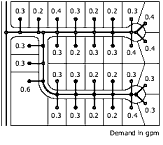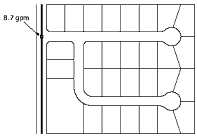Skeletonization Example
The following series of diagrams illustrate various levels of skeletonization that can be applied. The diagram below shows a network subdivision before any skeletonization has been performed.
There is a junction at each service tap and a pipe and node at each house for a total of 48 junctions and 47 pipes within this subdivision.
To perform a low level of skeletonization, the nodes at each house could be removed along with the connecting pipes that tie in to the service line. The demands at each house would be moved to the corresponding service tap. The resulting network would now look like this:
There are now 19 junctions and 18 pipes in the subdivision. The demands that were assigned to the junctions that were removed are moved to the nearest upstream junction. The only information that has been lost is the data at the service connections that were removed.
A further level of skeletonization is possible if you remove the service taps and model only the ends and intersections of the main pipes. In this case, re-allocating the demands is a bit more complex. The most accurate approximation can be obtained by associating the demands with the junction that is closest to the original demand junction (as determined by following the service pipe). In the following diagram, these service areas are marked with a dotted line.
To fully skeletonize this subdivision, the pipes and junctions that serve the subdivision can be removed, and the demands can be assigned to the point where the branch connects to the rest of the network, as shown in the following diagram.
As can be seen by this example, numerous levels of skeletonization can be applied; determining the extent of the skeletonization depends on the purpose of the model. At each progressive level of skeletonization, more elements are removed, thus the amount of available information is decreased. Deciding whether this information is necessary to the intended use of the model dictates the point at which the model is optimally skeletonized.




